June 21, 2025 | 02:51 GMT +7
June 21, 2025 | 02:51 GMT +7
Hotline: 0913.378.918
June 21, 2025 | 02:51 GMT +7
Hotline: 0913.378.918
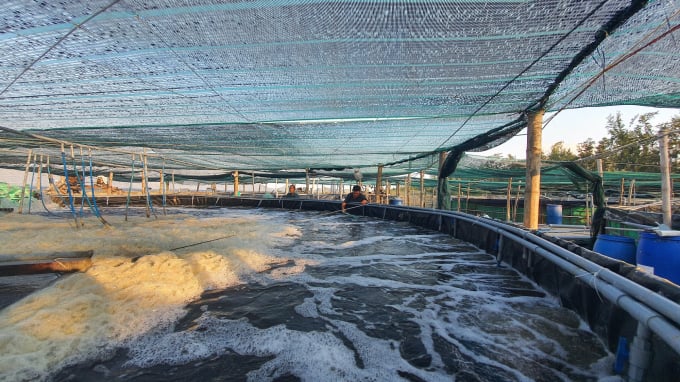
RAS shrimp farming will be divided into 3 stages in different tanks. Photo: L.K.
In recent years, diseases have been appearing on shrimp due to water sources and shrimp farming environment pollution, making many farmers suffer heavy losses. Therefore, the application of advanced technologies to treat water and ensure the best living conditions for shrimp is extremely necessary.
On that basis, in 2020, a research project on applying technology to stabilize the water environment in super-intensive shrimp farming ponds has been implemented.
The project is carried out by SAEN Environmental and Aquaculture Science Co., Ltd, with Dr. Nguyen Nhut, Deputy Head of Experimental Biology Office, Research Institute of Aquaculture No. 2 as the project leader.
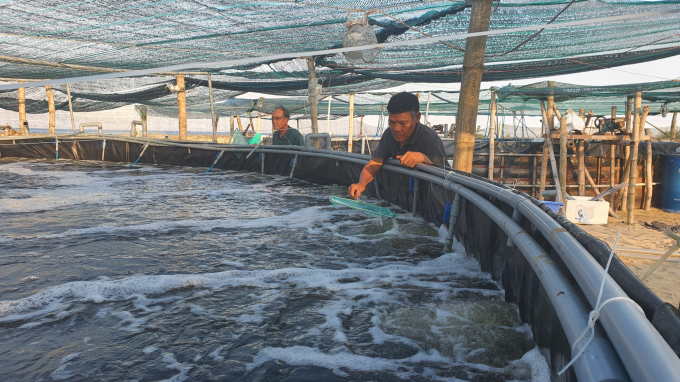
The water in the shrimp pond is recirculated after treatment and always keeps the indicators stable to ensure the best living environment for shrimp. Photo: L.K.
The model is deployed in Duc Chanh commune (Mo Duc district), on a scale of 700m2. Shrimp farming will be divided into three stages in different tanks. In the first stage, seeds were stocked in a 100m2 tank at a density of 1,020 shrimp/m2. When shrimp enter the 2nd month, they will be transferred to another 200m2 tank. In the final stage, they will be raised in a 400m2 tank.
Following this technology, the entire farming area uses tarpaulin-lined iron frames. In particular, during the rearing process, there is no need to change the water at all since the cultivating environment will be continuously treated through 2 solid-waste treatment systems with membranes and dissolved waste using microorganisms.
The water in the pond circulates continuously, and after being treated, the water for shrimp farming returns to the lake to ensure clean and safe criteria for shrimp to grow, minimizes disease and uses completely zero antibiotics.
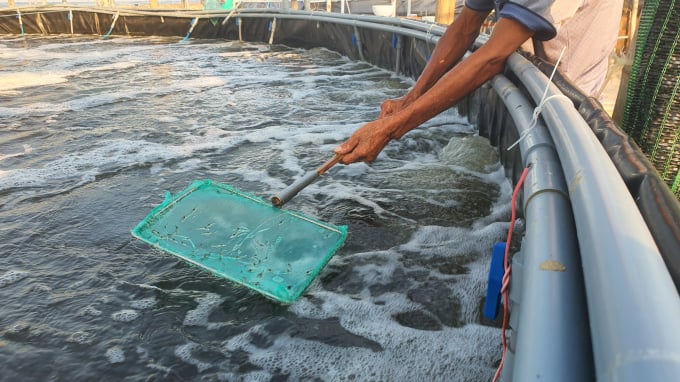
Raised shrimp live in a clean water environment, which will minimize disease while not using antibiotics. Photo: L.K.
“… Because this technology does not change the water, it will prevent the transmission route of the disease source following the changed water. In addition, when rearing in 1 month each, when the pathogen has not yet developed, we have already cleaned and put the shrimp back in”, claimed Dr. Nguyen Nhut.
In Vietnam, the model deployed in Duc Chanh commune is the first model to be deployed on a household scale. Compared to the application in the Institute of Fisheries, household farming will have adjustments to simplify all processes, omitting some stages to help farmers easily perform.
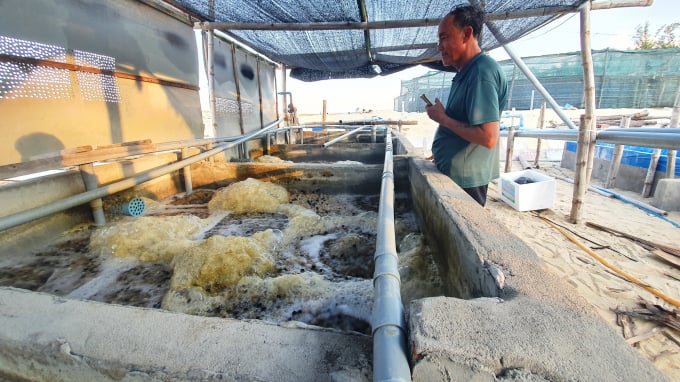
The microbiological treatment system will remove dissolved wastes and return clean water to the tank. Photo: L.K.
Regarding the possibility of widespread application of the model when the technology is proven effective, in accordance with Mr. Nhut, it will take about 6 months for farmers to understand and put the model into practice. Because the problem with this system is that the person operating the recirculation system does not know how to raise shrimp and the farmer does not understand how the system works.
“This is still the biggest failure of the RAS technology. In order to operate the system, one must possess lots of knowledge from farming, mechanics, water quality to chemistry, biology... Therefore, although this technology has the highest density, I am choosing a moderate level for farmers to learn. During the training process, they will gradually gain knowledge and increase the farming density to increase economic efficiency", said Mr. Nhut.
According to Mr. Nguyen Van Thanh, Director of the Department of Science and Technology of Quang Ngai province - the project's advisory unit, after nearly a year of implementing the model locally, RAS technology has shown initial results, farmed shrimp grew and developed well with zero diseases detected.
In the near future, at the end of the project, we will re-evaluate its effectiveness. On the practical basis, we will open a training class for about 50 farmers to access the technology, then later apply it into practice, increase economic efficiency, also gradually replicate in order to sustainably develop the province's shrimp farming", shared Mr. Thanh.
![Turning wind and rain into action: [9] Digitizing hydrometeorological data in response to climate change](https://t.ex-cdn.com/nongnghiepmoitruong.vn/608w/files/news/2025/06/17/z6704423696987_15fd32ffc26d590d204d520c9dac6786-nongnghiep-165943.jpg)
(VAN) Farmers have begun accessing hydrometeorological applications to adjust their cropping schedules, aiming to ensure productivity and adapt to climate change.
![Turning wind and rain into action: [8] Real-time salinity detection and early warning technology](https://t.ex-cdn.com/nongnghiepmoitruong.vn/608w/files/news/2025/06/17/z6704423696987_15fd32ffc26d590d204d520c9dac6786-nongnghiep-151127.jpg)
(VAN) Thanks to the integration of modern hydrological-hydraulic models, remote sensing technologies, and artificial intelligence, the accuracy of hydrological forecasting has significantly improved.
![Turning wind and rain into action: [7] Early disaster warnings help marine farmers minimize losses](https://t.ex-cdn.com/nongnghiepmoitruong.vn/608w/files/news/2025/06/17/z6704423696987_15fd32ffc26d590d204d520c9dac6786-nongnghiep-142942.jpg)
(VAN) In recent years, thanks to early disaster warnings and forecasting, marine farmers in Khanh Hoa province have been able to reduce risks and losses, thereby improving production efficiency.
![Turning wind and rain into action: [6] ‘Four on-the-spot’ disaster management software](https://t.ex-cdn.com/nongnghiepmoitruong.vn/608w/files/news/2025/06/17/e5a48259d6a262fc3bb3-nongnghiep-183800.jpg)
(VAN) By simply activating the scenario on the disaster management software, the relevant authorities immediately know how many households need to be evacuated, where to evacuate them to, and by what means of transportation…
![Turning wind and rain into action: [5] Hue applies modern technology in disaster forecasting](https://t.ex-cdn.com/nongnghiepmoitruong.vn/608w/files/news/2025/06/17/z6704423696987_15fd32ffc26d590d204d520c9dac6786-nongnghiep-093938.jpg)
(VAN) In Hue city, modern technology has recently been applied in meteorological and hydrological forecasting and warning, helping to reduce the damage caused by natural disasters.
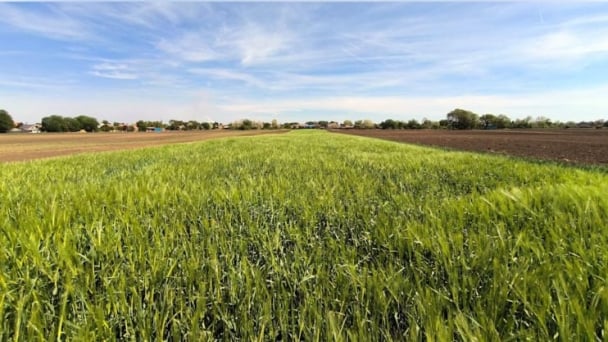
(VAN) A cutting-edge farming technique being implemented on an experimental ranch in Arizona's Sonoran Desert has already saved a billion gallons of water over five years, according to Civil Eats.

(VAN) Poultry and pig production and the environment can be boosted through enhanced water technology, according to new research.